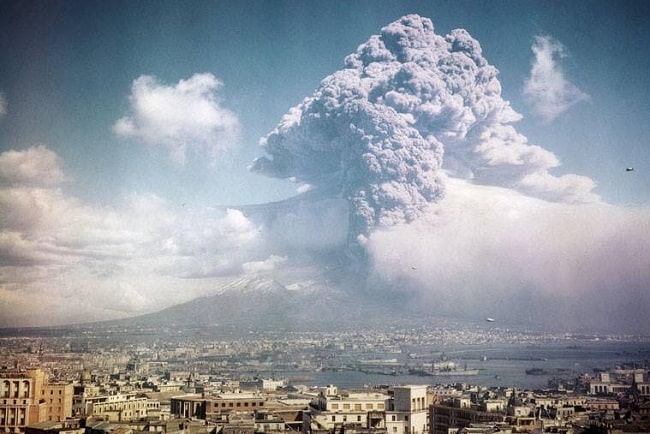
From the account of the British intelligence officer Norman Lewis (Naples '44, Eland Books, 1978), then in Naples in those days:
19 March: Today Vesuvius erupted. It was the most majestic and terrible spectacle I have ever seen (...). The smoke from the crater rose slowly in coils that seemed solid. It spread so slowly that no sign of movement could be seen in the cloud which by evening must have been 30 or 40 thousand feet high and stretched for many miles. (...)
At night rivers of lava began to run down the sides of the mountain. (...) Periodically the crater discharged into the sky serpents of blood-red fire that throbbed with flashes of lightning. (...)
22 March (...) Following reports that San Sebastiano was about to be swept away by the lava flow and that Cercola was threatened, I was sent to make a report on what was happening. (...)
I was directly beneath the great grey cloud, full of bulges and protuberances like a colossal pulsating brain. On reaching San Sebastiano, it seemed incredible that all those people could ever have chosen to live in such a place. The town had been built at the end of a tongue of land hitherto spared by the volcano, but completely surrounded by the tremendous lava fields left by the 1872 eruption, indeed actually in a valley between them. (...)
The 1944 eruption of Vesuvius. Here, in the middle of this volcanic “no-man’s-land”, any amateur would have predicted the destruction of the town with mathematical certainty, but apparently no citizen of San Sebastiano would ever have admitted the possibility. The bond with the town is a matter of religious faith. The buildings had been solidly constructed to endure for centuries (...) All the windows look westward, towards the green valleys leading to Naples, and the houses turn their backs on the grey, eternal cone of the volcano (...).
At the time of my arrival the lava was sliding quietly along the main street and, about 50 yards from the front of this overflowing mass, a crowd of several hundred people, most of them dressed in black, were kneeling in prayer (...). From time to time a more indignant citizen would seize a religious banner and wave it furiously at the wall of lava, as though to drive away the evil spirits of the eruption. (...)
A house, slowly encircled and then overtopped by the lava, disappeared intact from sight and there followed a faint, distant cracking as the lava began to swallow it. (...) A number of people, facing the eruption, were holding up holy pictures and statues, among them that of San Sebastiano himself; but on one side of the street I noticed, along with many people, the presence of another statue covered with a white sheet (...).
This was the image of San Gennaro, smuggled from Naples in the hope that it might be of use if all the others failed. It had been covered with the sheet to avoid giving offence to the confraternity of San Sebastiano and to the saint himself, who might have taken umbrage at this intrusion into his territory. San Gennaro would be brought out into the open only as a last resort. (...) The carabiniere did not think this would be necessary, since it was clear to him that the lava flow was slowing down.

